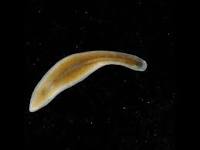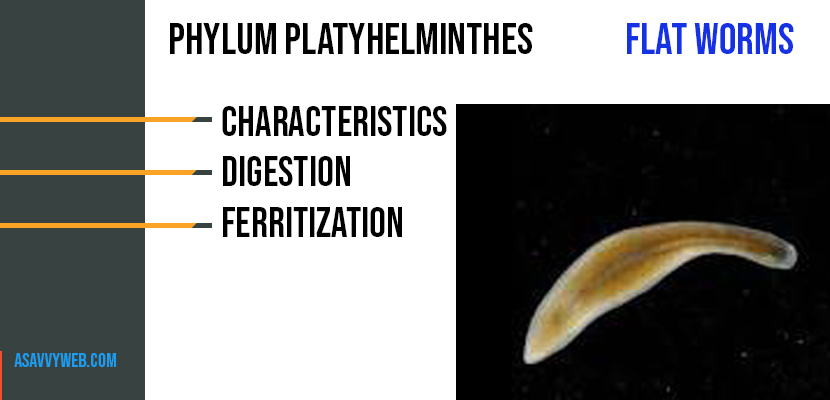The members of Phylum Platyhelminthes are dorsoventrally flattened. This phylum includes flatworms and they belong to kingdom Animalia and they are relatively simple bilaterian, unsegmented and soft bodied invertebrates and also known as flatworms. These are acoelomates, without a body cavity called coelom. The alimentary canal is either absent or very simple. Excretion and osmoregulation occur through flame cells. These worms are mostly hermaphrodites, having both male and female reproductive organs in a single individual. Most of the members are parasites. It is divided into three classes, namely Turbellaria, Trematoda and Cestoda.
Characteristics of Phylum Platyhelminthes:
Characteristics of Phylum Platyhelminthes are very important to know when you are studying about phylums and here is the brief explanation of 5 characteristics of phylum Platyhelminthes explained in detail:
| 1- The members of Platyhelminthes are formally called as flatworms because their body is dorsiventrally flattened. |
| 2- Mostly, the members of Platyhelminthes are endoparasites and they are found in animals including human beings |
| 3- Members of this Phylum Platyhelminthes are bilaterally symmetrical |
| 4- Tripiloblastic. |
| 5- Acoemeioes and having organ level of organisation. |
Bilaterally symmetrical that means their body can be divided in to two equal half’s by dividing them to any of them passing through any one of the pane passing through the central axis.
Tripilioblastic: Phylum Platyhelminthes are triploblastic organisms that is they are three embryonic germ layers i.e ectoderm, endoderm and mesoderm in between both of endoderm and ectoderm.
Acoeiomate: Phylum Platyhelminths are acoeimate organisms that is they don’t have cavity between the body wall and the gut wall(gastrointestinal wall).
Phylym Platyhelminthes: have organ level of organization that is specialized level of organs are present in them which perform some of the specified function and for each performed function each specialized organ is responsible.
These are 5 general characteristics of Phylum Platyhelminthes.

Phylum Platyhelminthes Digestion:
Digestive system in the members of Platyhelminthes is both intracellular and extra cellular. Platyhelminthes sexes are not separated that is they are hermaphrodite organism that is sperms and eggs are produced by the same individual only.
Fertilization is internal and there are special kind of cells which are present in the members which are called as flames cells which perform the function of both osmoregulation and excretion. Both these vital functions are performed by the specialized cells called as Flame cells.
Osmoregulation: Osmoregulation is the process by which water level is maintained in the body.
Excretion: Excretion is the process of removal of the wastage from the body and Hooks and Suckers are the specialized structures present in some of the members of phylum Platyhelminthes which are generally parasitic and in parasitic form these hooks and suckers are present.
Phylum Platyhelminthes Fertilization:
Fertilization is internal and development is indirect through mini larval stages. Some of the elements in Platyhelminthes for example Planaria processes a well develop regeneration capacity.
These are some of the general characters of phylum Platyhelminthes and the members which are included in this phylum are TAENIA which is called as tape worm, liver fluke which is called as fasciolia. These are some of the examples of Phylum Platyhelminthes.
Examples of Phylum Platyhelminthes are:
| Turbellaria |
| Tapeworm |
| Flukes |
| Monogenea |
| Rhabditophora |
Classes of Phylum Platyhelminthes:
Class Turbellaria :-
These are free living aquatic flatworms. The Planaria of this class shows characteristic regeneration.
Class Trematoda:
These are flukes living as parasites inside a host (endoparasites). A protective cuticle covers the outer surface of the body. Flukes have suckers for attachment to the host tissues.
The examples are Fasciola (liver fluke), Schistosoma (blood fluke).
Class Cestoda:-
It includes all tape worms. These are internal parasites with a complex life history. The life cycle involves two hosts.
Their body characters are adaptations for parasitic life. Mouth and alimentary canal are absent. Food is absorbed through general body surface. The head is called the scolex. It has a ring of hooks and suckers for attachment to the host tissue. The body consists of several segments called Proglottids. (eg) sheep and cattle tape worms.
The live in fresh water, ponds, lake, streams and they are eco friendly found in shores
They are worms but they do contain bacteria which contains allergic reactions and avoid touching warms with bare hands.
Tape worm, liver fluke, Termatoda and cestoda.
They belong to Animalia kingdom.

